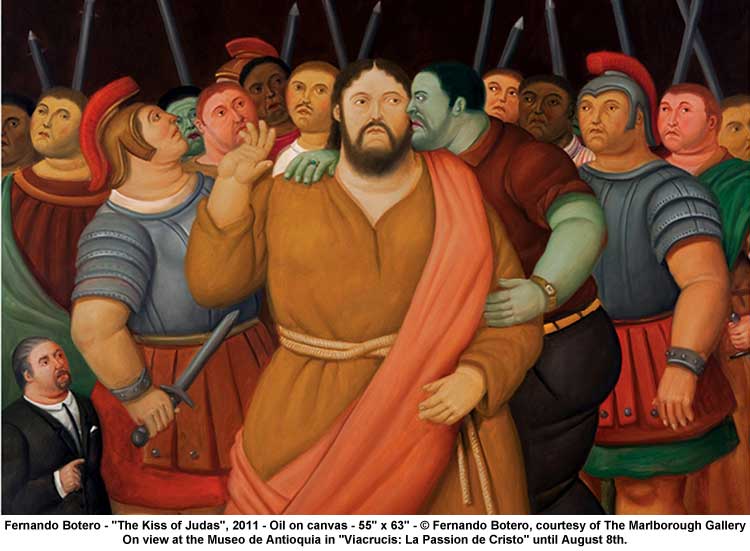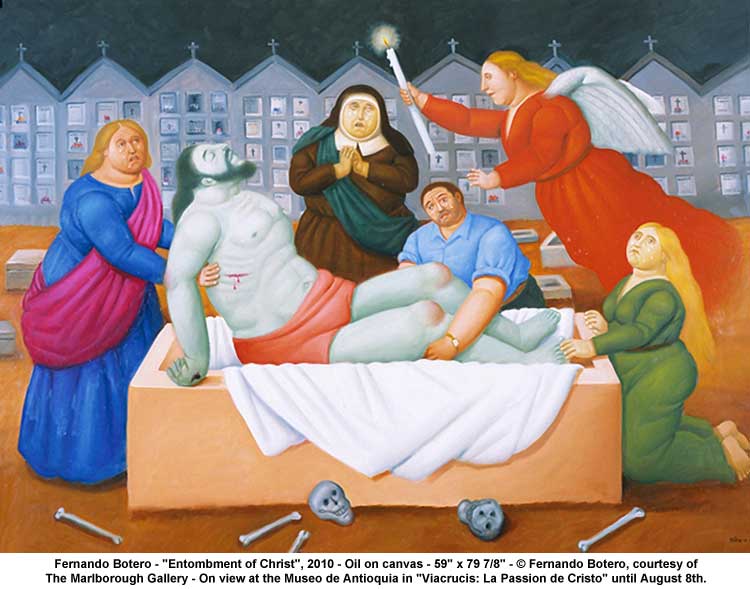The Museo de Antioquia celebrates Fernando Botero’s 80th Birthday
Medellin, Colombia.- The Museo de Antioquia is proud to celebrate the 80th birthday of the Medellin-born and resident Fernando Botero by presenting “Viacrucis: La Passion de Cristo” on view through August 8th. Viacrucis —a Latin word meaning “the path of the Cross”— comprises 27 large-format oil paintings and 33 drawings. On display in this show are Botero’s careful study of and deep love for the Italian primitives of the first half of the Fifteenth Century and for the artists of the Renaissance. Many artists painted the passion of Christ in scenes that included medieval fortresses and hill-dotted landscapes; now Botero approaches the subject in contexts that incorporate Manhattan or small Antioquia towns.
One of the largest works in the show is a Pieta measuring 93 x 58” while a Descent of the Cross measures 90 by 50”. Smaller works measuring 20 x 20” lose no power from their size and are made all the more touching by their very intimacy. The hallmark of all the paintings regardless of size and subject is Botero’s stunning use of color that charges the works with both seductive beauty and elemental impact. Just as in his paintings of the Abu Ghraib prison, these works depicting Christ’s Passion are intense and powerful not only because of the events depicted but also because of Botero’s ability to convey pathos and emotion. Botero can be humorous and whimsical as some of his paintings over the years reveal, but he can also turn his considerable talents to portray tragic events as the paintings in this show effectively demonstrated.
Botero has all his life been an avid observer of old master paintings and to this day he is a constant museum goer. His work has often been infused with various references to the masters either by subject such as his take on van Eyck’s The Marriage of Arnolfini or by subtle references to structure and technique. What becomes immediately clear in the Via Crucis exhibition is Botero’s long study and great love of the early Italian primitives of the first half of the fifteenth century as well as the early northern Renaissance painters. What those painters strove to achieve was a way to express naturalism of human form and to create a means to convey in regard to the story of Christ the great emotion and feeling of the event. Botero has in his inimitable, elegant style taken up this heroic and exalted subject and in a unique manner has, while remaining faithful to the events of the story, transformed it. In so doing he has achieved one of the most commanding cycles of works he has painted to date. Through a singular vision of the expression of human emotion and spirit these works are destined to be a high water mark of the artist’s entire career. Just as the old master painters used places and people of their time to depict the Passion, Botero uses places and events of our time to portray The Way of the Cross. To give just a few examples, the background setting in one depiction of Christ’s crucifixion is Manhattan; in the flogging of Christ, instead of Roman soldiers we see Colombian soldiers; in The Kiss of Judas we see a small figure in the left hand corner which is a self-portrait, and in Ecce Homo Pontius Pilate is represented by an accusatory finger and the village is a town in Botero’s home state of Antioquia in Colombia.
In the introduction essay to the exhibition catalog the writer Cristina Carrillo de Albornoz writes, “Botero, who in his own words is ‘at times a believer, at times an agnostic,’ has captured the intensity and cruelty but also the piercing poetry of the tremendous drama of Christ’s journey along the Way of the Cross toward his crucifixion.” In regard to Botero’s style she astutely quotes the English poet, Francis Bacon, “There is no excellent beauty that hath not some strangeness in the proportion.” Botero’s style is distinctly his own and highly original. His art, both in painting and sculpture, strikes a universal chord that goes beyond regional tastes and temporal values and reaches a fundamental feeling in people all over the world. There is perhaps no other living artist who has so many admirers and collectors. His work is recognized and sought-after as much in the United States, South America, and Europe as it is in South Africa, Asia, and Australia. Asia Pacific Sculpture News attributed this phenomenon to “a vision of humanity that transcends the boundaries of cultural specificity, a vision of humanity that pulsates to the ancient universal rhythms of life.”
Botero was born in Medellín, Colombia in 1932. He moved to Bogotá in 1951 and had his first show there the same year at Galeria Leo Matiz. His first retrospective took place in 1970 in Germany at museums in Baden Baden, Berlin, Dusseldorf and Hamburg. Since then, Botero has continually showed in museums all over the world. In the last ten years he has had an astounding number of museum shows in the following countries: Argentina, Belgium, Brazil, Chile, Colombia, France, Germany, Greece, Israel, Italy, Japan, Korea, Mexico, the Netherlands, Portugal, Spain, Sweden, Switzerland, Uruguay, Venezuela, and the United States.Botero’s work can be found in forty-six museums. Among the most prominent are: The Baltimore Museum of Art, Maryland; the Israel Museum, Jerusalem; The Metropolitan Museum of Art, New York; Hirshhorn Museum and Sculpture Garden, Washington, D.C.; Museo de Arte Contemporáneo de Caracas, Venezuela; Museo de Arte Moderno, Bogotá, Colombia; Museo Nacional de Bellas Artes, Santiago, Chile; The Museum of Modern Art New York; Neue Pinakothek, Munich, Germany; Pushkin Museum, Moscow, Russia; The Solomon R. Guggenheim Museum, New York; Wallraf-Richartz Museum, Cologne, Germany; and The State Hermitage Museum, St. Petersburg, Russia. Many books have been published on Botero’s work in English, Spanish, French, German Italian, Chinese and Japanese.
The Museum of Antioquia was founded in 1881 and was the first in the region, only the second museum in Colombia and one of the first South American museum’s to feature an art room. In the first 60 years, the collection consisted mostly of objects representing important historical moments of Antioquia and Colombia. However, during the twentieth century, with the help of the Society of Public Improvements in Medellin, the museum began to expand its collection and displays of art. In 1975 the institution received the picture “Ex voto” from the Medellin-born Fernando Boteroa, and this paved the way for a close relationship, with Botero making further donations in the following years. Today the museum has a collection of over 5,000 pieces ranging from archaeological to contemporary art, spanning all eras of the history of Colombia. The building has an area of 14,500 m2, distributed over 4 floors. It is located in the historic center of town and was declared an Architectural Heritage of the Nation and restored in the 1990’s by the Antioquia Railway Foundation.
Source: http://www.artknowledgenews.com


